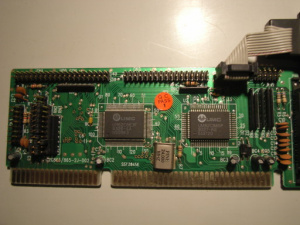Difference between revisions of "UM82C86"
From Hackbox
| Line 88: | Line 88: | ||
If this IO Card is the only HDC in your computer, then the switch JP8 must be at NOT EXIST. | If this IO Card is the only HDC in your computer, then the switch JP8 must be at NOT EXIST. | ||
| − | Thanks to the info I found [http://ceres.ugr.es/~atv/Documents/Docencia/UMC | + | Thanks to the info I found [http://ceres.ugr.es/~atv/Documents/Docencia/UMC%20UM82C86.htm here]. |
The card may be of interest because: | The card may be of interest because: | ||
Latest revision as of 02:20, 21 July 2010
This is an ISA AT Card featuring:
- 1 IDE port
- 1 floppy port
- 2 serial ports
- 1 parallel port
- 1 game port
The card was part of a 486DX66.
It has two ICs:
- UM82C863F
- UM82C865F
The PCB is marked with TK-82C863/865-2J-D02
There is a jumper block:
| Jumper | Position | Description | |
|---|---|---|---|
| 1-2 | 2-3 | ||
| JP1 | COM2 | COM4 | Serial port 2 switch |
| JP2 | Enabled | Disabled | Serial port 2 |
| JP3 | Enabled | Disabled | Game port |
| JP4 | COM1 | COM3 | Serial port 1 switch |
| JP5 | LPT1 | LPT2 | Parallel port switch |
| JP6 | Enabled | Disabled | Serial port 1 |
| JP7 | Enabled | Disabled | Floppy Controller |
| JP8 | Exist | Not Exist | Other HDC |
| JP9 | Enabled | Disabled | IDE HDC |
| JP10 | Enabled | Disabled | Parallel port |
And two additional jumpers:
- J1: IDE IOCHRDY (OPTIONAL)
- J2: HD LED
COM1 and 3 use IRQ 4, and COM2 and 4 use IRQ 3.
If this IO Card is the only HDC in your computer, then the switch JP8 must be at NOT EXIST.
Thanks to the info I found here.
The card may be of interest because:
- it has an old floppy controller (which is important for floppy imaging)
- it has an old parallel port (for use with an X1541 cable)
The difficulty is to avoid IRQ conflicts. How to disable the on board devices in pentium-age PCs in favour of this card?
